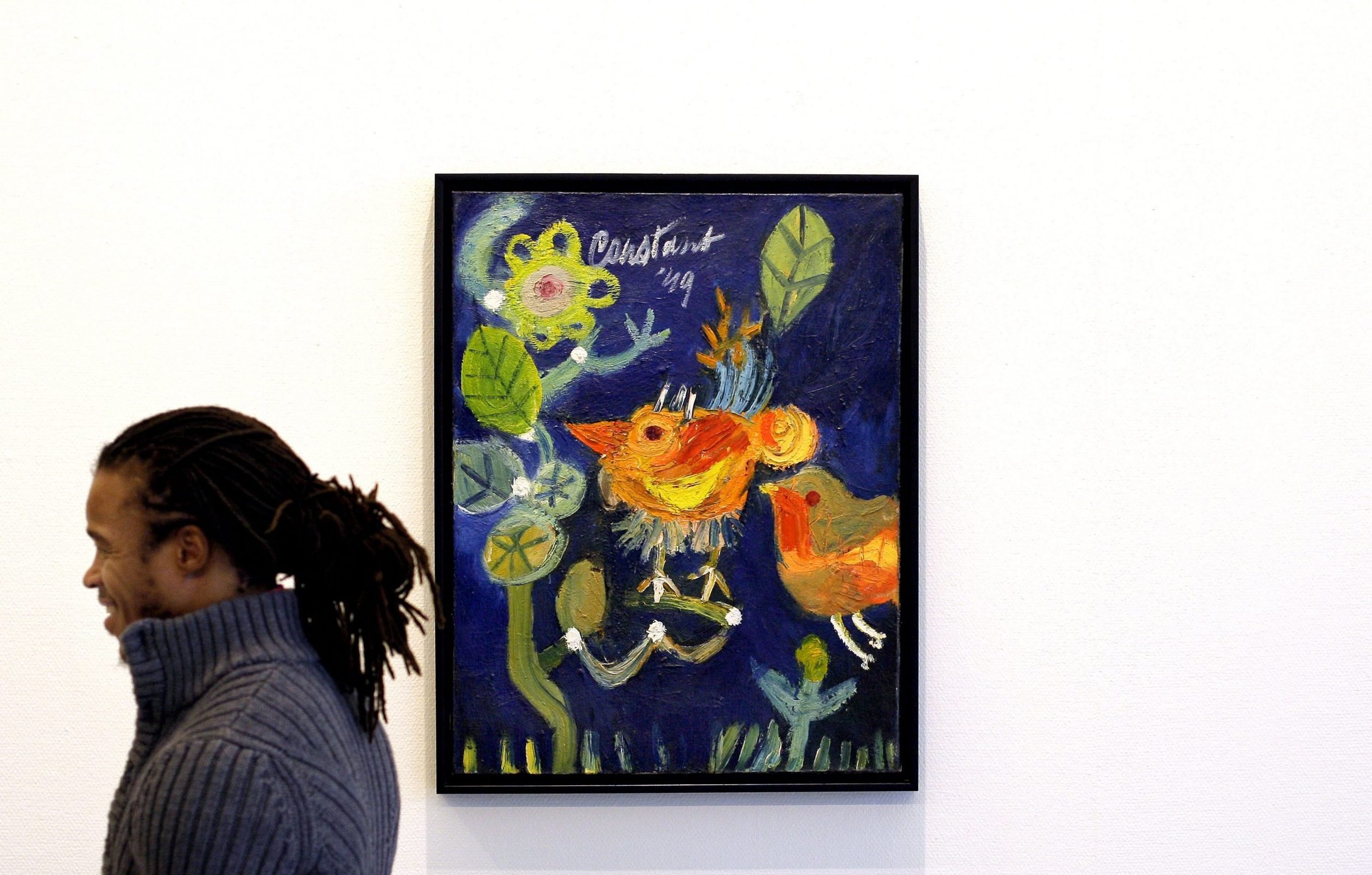
Willemijn Stokvis, the preeminent art historian on CoBrA, considers it “the last avant-garde movement of the 20th century.” This radical group, active from 1948 to 1951, named itself for the home cities of its founding members: Copenhagen, Brussels, and Amsterdam. CoBrA, which eventually touted 40-odd members, was also the first international avant-garde movement to follow World War II.
Who spearheaded CoBrA?
Belgian poet Christian Dotremont coined CoBrA’s name and penned its manifesto. Danish painter, sculptor, and author Asger Jorn proved his necessary counterpart. “We had non-stop discussions and disagreed on almost all points,” Jorn said in 1967, according to the Museum Cobra. “We wanted to understand each other in order to agree.”
But how did CoBrA actually start?
CoBrA’s story starts in 1946, when the Dutch artist Constant Nieuwenhuys, known as Constant, met Jorn at a Joan Miró opening in Paris. Jorn, who had been exposed to more progressive art due to Denmark’s more lax occupation during the war, showed Constant the ropes of experimental, international art. Meanwhile, in Belgium, Dotremont, a communist Revolutionary Surrealist like Jorn, began tiring of the movement’s bourgeois obsession with theory. Dotremont sought an art that could create social change by arousing humanity’s latent creativity.
In 1948, artists converged on Paris for an international avant-garde conference. Dotremont dashed off CoBrA’s manifesto, titled “La cause était entendue” (“The Case Was Settled”), riffing off the Revolutionary Surrealists’ manifesto “La cause est entendue” (The Case Is Settled), as a revolt against the conference’s authoritarian overtones. CoBrA’s six sympathetic founding members—including Jorn and Constant, his fellow Dutch experimental painters Karel Appel and Corneille, and the Belgian painter Joseph Noiret—signed Dotremont’s manifesto at the Hôtel Notre Dame cafe.
Works by CoBrA founder Asger Jorn on view at “Open Creation and its Enemies: Asger Jorn in Situation,” at the Institut Valencia d’Art Modern (IVAM) during February, 2023. Photo: Rober Solsona/Europa Press via Getty Images.
What did it mean to be a CoBrA artist?
Lively involvement animated the group, which was aimed towards action. CoBrA’s artists followed four principles: “creation before theory; art must have roots; materialism which begins with the material; the mark as a sign of wellbeing, spontaneity, experimentation.” Still, varying beliefs about CoBrA’s mission abounded, whether focused on politics or interdisciplinary pollination.
Their aesthetics transcended the art world, drawing instead from outsider, folk, and prehistoric art. Works by CoBrA’s artists were colorful, textured, and purposefully childlike. They often featured animals and spontaneous, gestural brushstrokes, evoking Abstract Expressionism while avoiding that movement’s obsession with singular genius. As it grew, the movement was overwhelmingly male, but did notably include one Black man—the South African sculptor Ernest Mancoba, who was married to the Dutch sculptor Sonja Ferlov.
Visitors look at the painting Abrupte Fable (C) by Pierre Alechinsky and Christian Dotremont (1976) on November 13, 2008 during the exhibition “Cobra” at the Royal Museum in Brussels. Photo: Dominique Faget/AFP via Getty Images.
What else happened in CoBrA’s lifetime?
Writers like the German poet Anneliese Hager and artists like Dutch painter Eugène Brands joined their ranks. CoBrA began churning out a journal, collaborative paintings, and shows. In 1949, the Stedelijk Museum in Amsterdam organized their first institutional show, even buying canvases for the 29 cash-strapped artists. The Dutch press called their art “scribble, claptrap, and splotches,” elevating CoBrA to European infamy. “At the exhibition itself,” Christie’s noted, “a reading of CoBrA poems incited audience members to fistfights.”
The movement disbanded after its second institutional exhibition, at the Palais des Beaux-Arts in Liège, during 1951. Private collectors had funded the exhibition of 33 artists, including talents only loosely affiliated with the group, like Miró and Alberto Giacometti, thus entangling CoBrA with commercial art. CoBrA quit while it was ahead.
Corneille’s studio on November 13, 1995 in Paris, France. Photo: Catherine Panchout – Corbis/Sygma via Getty Images.
So, did they really leave their mark on art?
CoBrA’s disbandment didn’t mean its artists stopped working. Jorn went on to help create the Situationists. Others, like Belgian artist Pierre Alechinsky and Danish artist Else Alfelt, remained true to the CoBrA style. Stokvis published her first, definitive text on CoBrA in 1974. Interest in the movement’s influence has steadily expanded since, as has the movement’s market.
The decades after CoBrA’s demise saw occasional in-fighting over who got to call themselves a true CoBrA; in 1999, Constant and Corneille even went after the Museum Cobra for including two ambiguous artists in their collection.
Whether the CoBrA artists truly accomplished their goals remains up for debate, but their mark on history—Jean Dubuffet, Jean-Michel Basquiat, and more found inspiration in their work—reminds artists of struggles and questions that transcend generations.
For as long as there has been art, revolutionary movements have continually reshaped its creation and perception. Artcore unpacks the trends that have shaken uptoday’s and yesterday’s art world—fromthe elegance of 18th-century Neoclassicism tothe bold provocations of the 1990s Young British Artists.